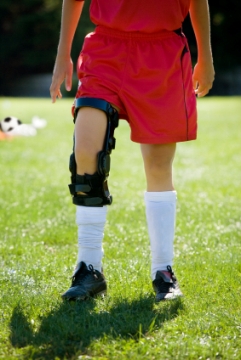A new research paper finds the overall rate of anterior cruciate ligament (ACL) injuries among high school athletes is significantly higher among females, who are especially likely to experience ACL tears while playing basketball, soccer and lacrosse.
Researchers at the Children's Hospital of Philadelphia found significant risk of ACL injury among both genders, particularly in high-risk sports such as soccer, football, basketball and lacrosse. While the majority of ACL injuries occur in boys, the rate of injury per exposure is higher in girls. Specifically, in girls, the highest ACL injury risks per season were observed in soccer (1.1 percent), basketball (0.9 percent), and lacrosse (0.5 percent). In comparison, the highest risks per season for boys were observed in football (0.8 percent), lacrosse (0.4 percent), and soccer (0.3 percent).

"It has been well established that the risk for ACL tear per athletic exposure is higher in female athletes compared to males," said lead author Alex L. Gornitzky, a fourth-year medical student at the Perelman School of Medicine at the University of Pennsylvania. "As participation rates in high school athletics continues to rise significantly, it has become increasingly important to establish up-to-date, individualized injury information for high school athletes and their families, who represent a large proportion of patients visiting pediatric orthopaedic and sports medicine clinics."all (0.8 percent), lacrosse (0.4 percent), and soccer (0.3 percent).
Knowledge of such sport-specific, seasonal risk is essential for evidenced-based parent-athlete decision-making, accurate physician counseling, and targeted injury-reduction programs for the most at-risk sports, said Gornitzky.
The results of the research paper are consistent with those of a 2013 study which found that, while ACL injuries did not disproportionately affect female high school athletes overall, girls were found to have a significantly higher ACL injury rate than boys in sex-comparable sports (soccer, basketball, and baseball/softball), with girls 2 times more likely to suffer an ACL injury playing soccer than any other sport, and 4 times more likely to sustain such an injury playing either soccer or basketball than volleyball or softball.
Start prevention efforts early
Neurmuscular training (NMT) programs, including the FIFA 11+ program, a 20-minute series of warm-up exercises performed at the start of each training session and in a modified form before matches, and the PEP exercise program developed by the Santa Monica Orthopedic and Sports Medicine Research Foundation, a series of 19 warm-up, stretching, strengthening, plyometric, and sport-specific agility exercises that can be completed in less than 30 minutes without any specialized equipment, have both been proven effective in a series of studies in reducing ACL injuries, particularly of the non-contact variety, and especially among female athletes, who more prone to ACL tears.
But research suggests that pre- or early adolescence may be the best time to start NMT in order to reduce the number of ACL injuries female athletes suffer.
Performing a "meta-analysis" of data from 14 studies published between 1999 and 2012, researchers at Cinncinati Children's Hospital found a 72% risk reduction in female athletes under 18 years old versus a risk reduction of only 16% for those over age 18. The data indicated that pre- or early adolescents (mid-teens) showed the greatest risk reduction (72%) compared with late adolescents (late teens; 52% risk reduction).
The study found, however, that the odds a female athlete would suffer an ACL injury after NMT in early adulthood or their late teens were 3.6 and 1.7 times higher, respectively, than if they began NMT in their mid-teens.
The data "could indicate that the potential window of opportunity for optimized ACL injury risk reduction may be before the onset of neuromuscular deficits and peak knee injury incidence that occurs after the onset of maturation in female athletes and/or during the mid-teen years," said lead author, Gregory D. Myer, PhD, FACSM, CSCS, of the Division of Sports Medicine at Cincinnati Children's Hospital, and the Departments of Pediatrics and Orthopaedic Surgery, at the College of Medicine at the University of Cincinnati, and the Athletic Training Division, School of Allied Medical Professions at The Ohio State University in Columbus.
The results "support the contention" - suggested in previous studies - "that younger athletes may be more receptive to NMT, which will lower their risk of injury," Myer writes, "compared with interventions implemented in late adolescents and early adult-aged female athletes.The higher risk of injury in postpubertal athletes has been attributed to several changes that occur thoughout the pubertal period, such as structural/anatomic changes, hormonal variations, and decreased strength."
The study noted that another possible explanation for the great NMT effectiveness in the mid-teen age group may be variability in the "quality" of athletes participating in the cutting, pivoting, and jumping sports such as soccer, volleyball and basketball in the younger ages, so that targeting NMT to athletes who are at higher risk results in greater reduction of that risk.
Sources:
American Academy of Pediatrics
Research paper, "Sport-Specific Yearly Risk and Incidence of Anterior Cruciate Ligament Tears in High School Athletes: A Systematic Review and Meta-Analysis." Presented at American Academy of Pediatrics National Conference & Exhibition, October 24-27, Washington, DC.
Joseph AM, Collins CL, Henke NM, Yard EE, Fields SK, Comstock RD. A Multisport Epidemiologic Comparison of Anterior Cruciate Ligament Injuries in HIgh School Athletics. J Athl Tr. 2013;48. DOI:10.485/1062-6050-48.6.03 (epub November 11, 2013).
Myer GD, Sugimoto D, Thomas S, Hewett T. The Influence of Age on the Effectiveness of Neuromuscular Training to Reduce Anterior Cruciate Ligament Injury in Female Athletes. Am. J. Sports Med. 2012; 20(10). DOI:10.1177/0363546512460637 (published online ahead of print October 8, 2012)(accessed October 15, 2012).
Posted October 23, 2015








